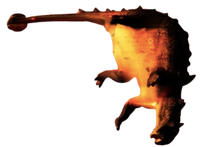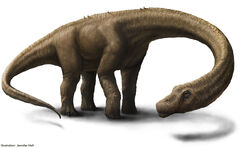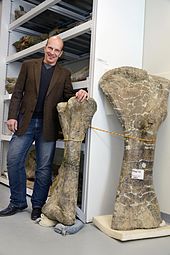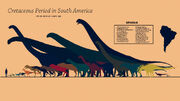
| Dreadnoughtus Temporal range: 99-94 Ma | |
|---|---|

| |
| A restoration of Dreadnoughtus schrani | |
| Scientific classification | |
| Kingdom: | Animalia |
| Phylum: | Chordata |
| Clade: | †Titanosauria |
| Order: | †Saurischia |
| Suborder: | †Sauropodomorpha |
| Genus: | †Dreadnoughtus Lacovara et al., 2014 |
| Species: | †D. schrani |
| Binomial name | |
| Dreadnoughtus schrani Lacovara et al., 2014 | |
Dreadnoughtus (Greek for "Fear Nothing"), is an extinct genus of titanosaurian sauropod dinosaur that inhabited the forests and plains of present-day Argentina, in-between 100 to 66 million years ago, which was discovered in 2005 and described later in 2014. Large animals (such as sauropods) tend to fossilize slowly and are usually known from small quantities of bones. However, the very first fossils ascribed to this taxon were reconstructed with a 45% complete skeleton (70% of the animal was restored accurately), making it one of the finest examples of a well-preserved sauropod.
Dreadnoughtus was initially believed to have been the heaviest dinosaur, being even greater in mass than a Boeing airplane (at a whopping 59 tonnes), though more modern estimates put that around 38 tonnes and with a length of 26 meters. The holotype skeleton is considered to be a juvenile specimen, meaning it's likely Dreadnoughtus may have attained even greater amounts of size. "Dreadnought" is the term used to describe battleships made between the launch of HMS Dreadnought in the early 1900s and the 1920s. Large World War II Battleships are typically referred to as "fast battleships". However, some still use the term "dreadnought" to refer to these.
Description[]
The discovery of Dreadnoughtus schrani provides insight into the size and anatomy of giant titanosaurian dinosaurs, especially of the limbs and the shoulder and hip girdles. The majority of D. schrani bones are very well preserved. There is minimal deformation, especially in the limb bones. Fine features, such as locations of muscle attachment, are frequently clearly visible. It is also possible that Dreadnoughtus had large, back spines sticking out to the sides since it belongs to the lithostrotians, a class of titanosaurs that had large spines. Dreadnoughtus also has an unusually long neck for its body size, making up almost half of the animal's length.
Size[]
| Dimension | Metric | Imperial |
|---|---|---|
| Maximum mass | 38,225 kilograms (38.225 t) | 42.1 short tons (84,200 lb) |
| Total length | 26 metres(m) | 85 feet (ft) |
| Head and neck length | 12.2 m | 40 ft |
| Neck-only length | 11.3 m | 37 ft |
| Torso and hip length | 5.1 m | 17 ft |
| Tail length | 8.7 m | 29 ft |
| Shoulder height | ~ 2 stories (6 m) | ~ 2 stories (20 ft) |

Size of the type specimen compared with a human
Estimates based on measurements of the known parts of the skeleton suggest that the only known individual of D. schrani was approximately 26 meters (85 feet) long and stood about 2 stories tall. At 1.74 m, its scapula is longer than any other known titanosaur shoulder blade. Its ilium, the top bone of the pelvis, is also larger than any other, measuring 1.31 m in length. The forearm of is longer than any previously known from a titanosaur, and it is only shorter than the long forearms of brachiosaurids, which had a more inclined body posture. Only Paralititan preserves a longer humerus (upper arm bone). Although each species likely had slightly different body proportions, these measurements demonstrate the massive nature of Dreadnoughtus schrani. The current estimate for the mass of the type specimen, created using a 3D skeleton and volume estimation of mass method, derives a range of 22.1–38.2 tonnes (21.8–37.6 long tons; 24.4–42.1 short tons).
Completeness[]
Completeness may be assessed in different ways. Sauropod dinosaur skeletons are often recovered with little to no skull material, so completeness is often looked at in terms of post-cranial completeness (i.e., the completeness of the skeleton excluding the skull). Completeness may also be assessed in terms of the numbers of bones versus the types of bones. The most important metric for understanding the anatomy of a fossil animal is the types of bones. The completeness statistics for Dreadnoughtus schrani are as follows:
- 116 bones out of ~256 in the entire skeleton (including the skull) = 45.3% complete
- 115 bones out of ~196 in the skeleton (excluding the skull) = 58.7% complete
- 100 types of bones out of ~142 types in the skeleton (excluding the skull) = 70.4% complete
The completeness of D. schrani compared with other extremely massive (over 40 metric tons) sauropods is as follows:
| Sauropod | Skeletal Completeness Total | Mirrored Postcranial Completeness (i.e. types of bones) |
|---|---|---|
| Dreadnoughtus schrani | 45.5% | 70.4% |
| Turiasaurus riodevensis | 44.1% | 45.8% |
| Futalognkosaurus dukei | 15.2% | 26.8% |
| Paralititan stromeri | 7.8% | 12.7% |
| Argentinosaurus huinculensis | 5.1% | 9.2% |
| Antarctosaurus giganteus | 2.3% | 3.5% |
| Puertasaurus reuili | 1.6% | 2.8% |
Thus, the skeleton of D. schrani is substantially more complete than those of all other extremely massive (40 metric tons) dinosaurs.
Posture[]
All titanosaurs had what is called wide-gauge posture, a relative term to describe a stance in which the feet fell apart from the body midline. More derived titanosaurs had a greater degree of wide-gauge posture, with their limbs held more widely than their ancestors and contemporaneous counterparts. The stance of Dreadnoughtus schrani was clearly wide-gauge, but not to the degree of saltasaurids because the femoral condyles are perpendicular to its shaft rather than beveled. This and the fact that the head of the femur was not turned in towards the body as in saltasaurids support the phylogenetic conclusion that Dreadnoughtus was not a saltasaurid. The animal’s broad sternal bones also demonstrate a wide pectoral girdle, giving it a broad-shouldered, broad-chested appearance. Paleontologist Kenneth Lacovara compared the animal's gait to an Imperial Walker's.
Although the forelimbs of D. schrani are longer than in any other previously known titanosaur, they are not significantly longer than the hind limbs. Therefore, Lacovara et al. (2014) reconstructed its neck to have been held more horizontally, rather than anteriorly inclined in the manner of Brachiosaurus.
Distinctive features[]
The tail of Dreadnoughtus schrani has several characteristic features included in the diagnosis of the species. The first vertebra of the tail has a ridge on its ventral surface called a keel. In the first third of the tail, the bases of the neural spines are extensively subdivided into cavities caused by contact with air sacs (part of the dinosaur’s respiratory system). In addition, the anterior and posterior boundaries of these neural spines have distinct ridges (pre- and postspinal laminae) connecting them to the pre- and postzygapophyses (the articulation points of the neural arches). In the middle of its tail, the vertebrae have a triangular process that extends over the centrum towards each preceding vertebra.
Just like modern archosaurs with tails (for example crocodilians, D. schrani had bones below the vertebrae called chevrons or haemel arches. These bones connect with the ventral surface of the vertebrae and are “Y” shaped when viewed anteriorly. In Dreadnoughtus schrani the bottom stem of the “Y” is broadly expanded, likely for the attachment of muscles.
The shoulder girdle and forelimb of D. schrani also exhibit unique features. An oblique ridge crosses the interior face of the scapular blade, extending from the top side near the far end of the blade to the bottom side near the base of the scapular blade. Finally, each end of the radius exhibits a unique form: the top, or proximal end, has a distinct concave embayment on its posterior face while the bottom, or distal end, is nearly square in shape instead of broadly expanded.
Discovery and study[]

Kenneth Lacovara with fibula and humerus of Dreadnoughtus
Kenneth Lacovara, of Drexel University, discovered the remains in the Cerro Fortaleza Formation in Santa Cruz Province, Patagonia, Argentina in 2005. Due to the large size of the bones and the remote location where they were found, it took his team four austral summers to fully excavate the remains. Mules, ropes and many team members were needed to finally get the field-jacketed bones to a truck.
In 2009, the fossils were transported to Philadelphia via an ocean freighter for preparation and study. Fossil preparation and analysis occurred at Drexel University, the Academy of Natural Sciences of Drexel University and the Carnegie Museum of Natural History. Dreadnoughtus schrani fossils will be returned to their permanent repository at the Museo Padre Molina in Rio Gallegos, Argentina.
The bones of both Dreadnoughtus specimens were scanned with a NextEngine 3D laser scanner. Using the software Autodesk Maya, the scans of each bone were positioned in 3D space to create a digital articulated skeleton, which was then converted into 3D PDF files using the software GeoMagic. The high fidelity of these scans allowed Lacovara et al. (2014) to study the heavy fossils of Dreadnoughtus schrani in a way that was safe for the fossils and enhanced virtual and long distance collaboration.
The holotype specimen, MPM-PV 1156, consists of a partial skeleton, somewhat preserved in its original layout, that comprises: a maxilla (jaw) fragment; a tooth; a posterior cervical vertebra; cervical ribs; multiple dorsal vertebrae and dorsal ribs; the sacrum; 32 caudal vertebrae and 18 haemal arches (bones from the tail) that include a sequence of 17 anterior and middle caudal vertebrae and their corresponding haemal arches found in their original layout; the left pectoral girdle and forelimb minus the front foot; both sternal plates; all pelvic elements; the left hind limb lacking a hind foot and right tibia; metatarsals I and II; and one claw from digit I.
The paratype, MPM-PV 3546, consists of a partially articulated postcranial skeleton of a slightly smaller individual whose remains were discovered in the same location as the holotype. It includes a partial anterior cervical vertebra, multiple dorsal vertebrae and ribs, the sacrum, seven caudal vertebrae and five haemal arches, a nearly complete pelvis, and the left femur.
In the early 20th century dreadnought was the term which was in worldwide use for the largest and state-of-the-art type of battleships, constructed after the revolutionary design concept of HMS Dreadnought. The name of the ship has a traditional lineage going back at least as far as 1553, and was originally derived from the words "dread" (fear) + "nought" (nothing).
According to the research team that discovered the taxon, the genus name Dreadnoughtus "alludes to the gigantic body size of the taxon (which presumably rendered healthy adult individuals nearly impervious to attack)" and to the two Argentine dreadnoughts that served in the first half of the twentieth century, Rivadavia and Moreno. Thus, the genus name also honors the country in which Dreadnoughtus schrani was discovered. The name of the type species, schrani, was given in recognition of the American entrepreneur Adam Schran for his financial support of the project.
Controversy over the mass/weight[]
The researchers who described Dreadnoughtus schrani estimated its weight using Equation 1 of Campione and Evans (2012), which allows the body mass of a quadrupedal animal to be estimated based only on the circumference of the humerus and femur. Using this scaling equation, they concluded that the Dreadnoughtus type specimen weighed about 59.3 tonnes (58.4 long tons; 65.4 short tons). By comparison, this would mean D. schrani weighed more than eight and a half times as much as a male African elephant and even exceeded the Boeing 737-900 airliner by several tons. This very large mass estimate was quickly criticized, though unofficially, by some other sauropod researchers. Matt Wedel used volumetric models that yielded a much lower estimate between 35–40 tonnes (34–39 long tons; 39–44 short tons), or even as low as approximately 30 tonnes (30 long tons; 33 short tons), based on a 20% shorter torso.
A formal re-evaluation of the animal's weight was published in June 2015. In it, a research team led by Karl T. Bates compared the simple scaling equation results with results found using a volume-based digital model with various amounts of soft tissue and "empty space" for the respiratory system. They found that any model using the scale-based weight estimate would have meant the animal had an impossible amount of bulk (fat, skin, muscle, etc.) layered onto its skeleton. They compared their D. schrani volumetric model to those of other sauropods with more complete skeletons and better understood mass estimates to conclude that the D. schrani type specimen must have weighed in the range of 22.1–38.2 tonnes (21.8–37.6 long tons; 24.4–42.1 short tons). Lacovara disputes the methods used by Bates et al., arguing that the new study treats Dreadnoughtus as an exception to well-established mass estimate methods proven on living animals, and that the limb bones would be unnecessarily large if the new mass estimates were correct.
Classification[]
Based on a cladistic analysis, Dreadnoughtus schrani appears to be a “derived” basal titanosaur that is not quite a lithostrotian. Lacovara et al. (2014) note that because of the wide array of relatively “advanced” and “primitive” features in the skeleton of Dreadnoughtus schrani and the current instability of titanosaurian interrelationships, future analyses may find widely differing positions for it within Titanosauria.
| Macronaria |
| ||||||||||||||||||||||||||||||||||||||||||||||||||||||||||||||||||||||||||||||
However, in a subsequent analysis of its limb bones, Ullman and Lacovara found that Dreadnoughtus possessed many of the characteristics of lithostrotians (in particular, it shares a number of traits with Aeolosaurus and Gondwanatitan), which collectively may indicate that it is actually a lithostrotian closely related to Aeolosauridae. While no new phylogenetic analysis was conducted, they suggested that future cladistic analyses should investigate the relationships between Dreadnoughtus, Aeolosaurus, and Gondwanatitan.
Paleobiology[]
Ontogeny[]
The holotype specimen was likely not fully grown when it died. The histology of the holotype humerus, which shows a lack of an external fundamental system (an outer layer of bone found only in fully-grown vertebrates) and abundant fast-deposited or still-growing woven tissue in the primary fibrolamellar bone of the outer bone cortex, led Lacovara et al. (2014) to determine that the specimen was still growing when it died. It remains unknown how large this individual would have grown had it not died when it did.
Taphonomy[]

Based on the sedimentary deposits at the site, the two Dreadnoughtus schrani specimens appear to have been buried quickly during a fluvial avulsion event, or break in a levee resulting in a flood. This event generated a liquefacted crevasse splay deposit which entombed the two dinosaurs. Thus, rapid and relatively deep burial of the Dreadnoughtus type specimen accounts for its extraordinary completeness. Numerous small theropod teeth found among the bones are likely evidence of scavenging, most likely by megaraptorans, perhaps Orkoraptor.
In popular culture[]
- Dreadnoughtus can be created in the game, Jurassic Park: Builder. At first, it could only in the Jurassic card packs purchasable by real money. Since June 10th 2016, it became a DNA tournament limited edition.
- Dreadnoughtus doesn't physically appear in the film, although it appears on the holographic globe in the Innovation Center in Jurassic World.
- Dreadnoughtus appeared in Dinosaur Train.
- Dreadnoughtus itself doesn't appear in the film, although it appears as a viable embryo at the end of the film Jurassic World: Fallen Kingdom.
- Dreadnoughtus makes an appearance as a dinosaur in Jurassic World Dominion. It is depicted partly submerging itself in the abundant lakes, which may or may not have happened in real life.
- Dreadnoughtus is an unlockable dinosaur in Jurassic World Evolution included in the Cretaceous Dinosaur Pack paid DLC, which released on December 13, 2018. It was also included in the base game for Evolution 2, with a body variant based on that of Jurassic World Dominion included in the Dominion Biosyn Expansion which released on June 14th, 2022.
- Dreadnoughtus makes an appearance in the 2022 Documentary series Prehistoric Planet, at the beginning of episode 2 titled "Deserts." In this scene, a group of a dozen males or so migrate to a large swarm of females in an open salt flat. The males employ speculative air-sac display structures to attract the females. This is plausible, but the air sacs would have most likely inflated bottom-top, instead of top-bottom like in this episode.
- Dreadnoughtus is the dinosaur basis for the mighty Dreadtrux in the two All-New Netflix Original Series’, Dinotrux and Dinotrux: Supercharged.
Gallery[]
Dreadnoughtus/Gallery